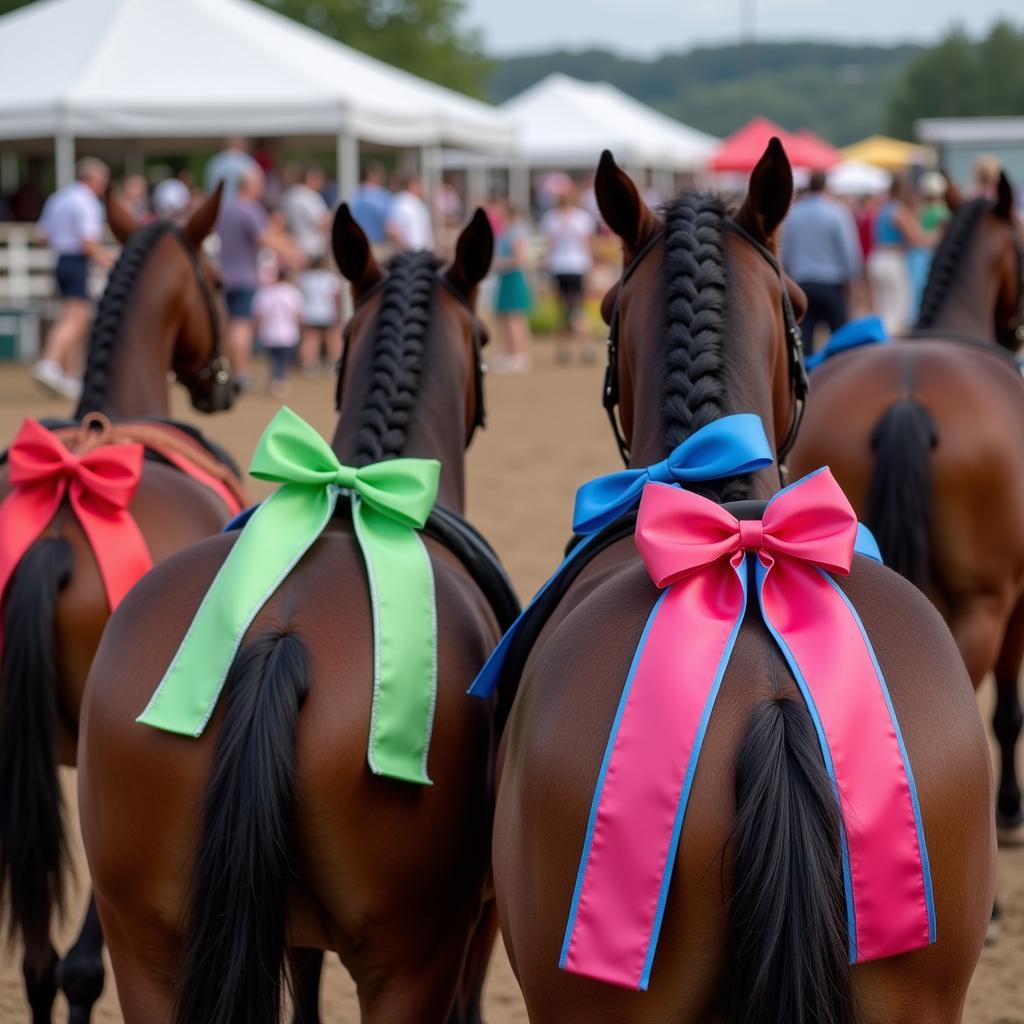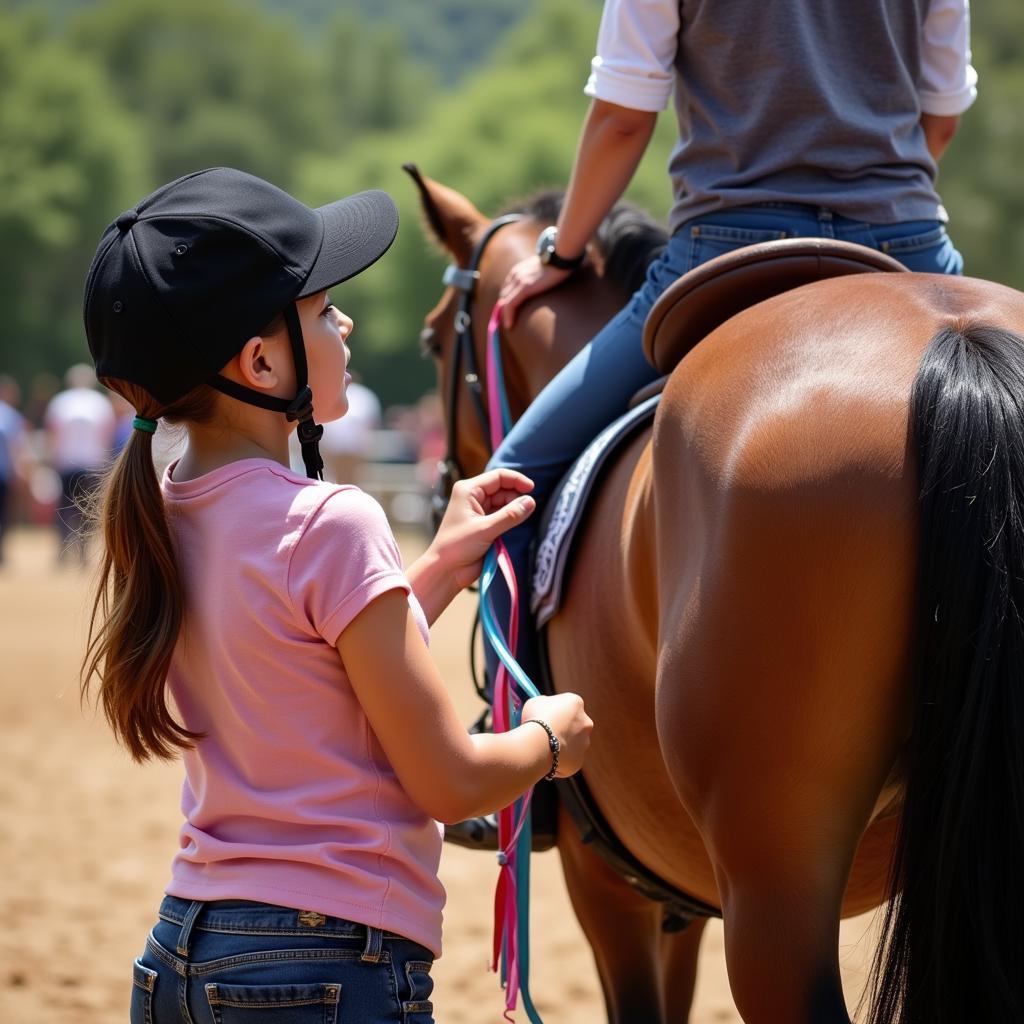Horse tail ribbons, a simple yet elegant adornment, are often seen gracing the flowing tails of our equine companions. But did you know these colorful additions are more than just a fashion statement? They actually carry deep meanings and traditions within the equestrian world. Understanding Horse Tail Ribbon Colors can provide valuable insights into the horse’s status, potential risks, or participation in specific events.
 Horse Show with Color Coded Ribbons
Horse Show with Color Coded Ribbons
Decoding the Rainbow: Common Horse Tail Ribbon Colors and Their Meanings
While interpretations may vary slightly depending on regional customs or specific disciplines, certain colors have universally recognized meanings:
Red Ribbon: A Universal Caution Sign
A red ribbon tied to a horse’s tail serves as a crucial warning to others. It signifies that the horse is known to kick, potentially posing a danger to anyone approaching from behind. This warning system helps maintain safety for handlers, riders, and other horses, especially in crowded areas like shows or trail rides.
Green Ribbon: A Gentle Reminder
Green ribbons often indicate a horse, typically a mare or stallion, is in heat. This visual cue helps manage interactions, preventing unwanted breeding behavior or aggressive displays between horses.
Blue Ribbon: The Victor’s Symbol
Most commonly associated with first-place prizes, the blue ribbon transcends its literal meaning. In the context of tail ribbons, it can signify a horse’s status as a previous champion or top performer, showcasing their achievements and talents.
Other Colors and Combinations: A Spectrum of Meanings
Beyond the core three, other horse tail ribbon colors carry specific meanings within different contexts:
- White: Often signifies a horse is for sale, particularly at auctions or sales events.
- Purple: Can represent a horse that is a proven broodmare with successful offspring.
- Pink: Typically used for mares or fillies, representing femininity.
- Yellow: Can indicate a stallion, cautioning handlers about their behavior.
Combinations of colors can also convey specific information. For instance, a red and white ribbon might indicate a horse is a kicker and for sale.
 Horse with Braided Ribbon Detail
Horse with Braided Ribbon Detail
Beyond Safety and Signals: Horse Tail Ribbons in Competition
Horse tail ribbons play a significant role in various equestrian competitions, serving both practical and traditional purposes:
Dressage: Elegance and Formality
In dressage, a discipline known for its elegance and precision, tail ribbons are often used to enhance the horse’s appearance and complement the rider’s attire. Neutral colors like white or black are common choices, maintaining a clean and polished look.
Eventing: A Colorful Tradition
Eventing, a challenging three-phase competition, often incorporates colorful tail ribbons into the cross-country phase. These ribbons are believed to bring good luck and are chosen based on personal preference or team colors.
Horse Shows: A Visual Language
Horse shows often have specific rules and guidelines for tail ribbons, using them to convey information about the horse’s class, division, or placement. For example:
- Hunter classes: Ribbons may be used to distinguish horses within a particular division.
- Jumper classes: Ribbons might be awarded for clear rounds or specific achievements.
Understanding the specific ribbon code used at a particular show is crucial for participants and spectators alike.
 Young Equestrian Preparing for a Show
Young Equestrian Preparing for a Show
Respecting the Tradition: Etiquette and Considerations
While horse tail ribbons might seem like a minor detail, observing proper etiquette demonstrates respect for the animal and the equestrian community:
- Always ask permission: Before tying a ribbon to a horse’s tail, always seek the owner or handler’s consent.
- Use appropriate materials: Choose ribbons specifically designed for horses, ensuring they are soft, durable, and safe for the animal.
- Tie ribbons securely, but not too tight: Ribbons should be attached firmly enough to stay in place but loose enough to avoid discomfort or tail damage.
- Remove ribbons carefully: After the event or purpose has passed, remove ribbons gently to prevent pulling or breaking the horse’s tail hairs.
Beyond the Basics: Exploring Further
For those seeking a deeper understanding of horse tail ribbon colors and their diverse interpretations, several resources can provide additional information:
- Breed associations: Many horse breeds have specific traditions and meanings associated with tail ribbons.
- Equestrian publications: Magazines and websites dedicated to the equestrian world often feature articles about horse care, traditions, and competition guidelines.
- Experienced equestrians: Talking to seasoned horse owners, trainers, or competitors can provide valuable insights into local customs and interpretations.
Remember, horse tail ribbons are more than just a pretty accessory. They are a form of communication within the equestrian world, conveying crucial information about safety, status, and participation. Understanding these meanings and traditions allows us to appreciate the subtle language of these colorful adornments and interact safely and respectfully with our equine partners.
FAQs about Horse Tail Ribbon Colors
Q: Are there specific regulations about horse tail ribbon colors at all competitions?
A: While some general guidelines exist, regulations can vary significantly between disciplines, organizations, and even individual shows. It’s crucial to consult the rulebook or competition guidelines beforehand to ensure compliance.
Q: Is it okay to use any type of ribbon on a horse’s tail?
A: It’s best to use ribbons specifically designed for horses. These ribbons are typically made from softer materials that won’t damage the tail hair and are less likely to cause discomfort or irritation.
Q: What should I do if I see a horse with a red ribbon but need to approach it?
A: Exercise extreme caution! A red ribbon signals a known kicker, and approaching from behind can be dangerous. If you must interact with the horse, alert the handler or owner so they can assist you safely.
Q: Can I use horse tail ribbons for purely decorative purposes?
A: While ribbons can add a touch of flair, it’s important to be mindful of their meanings within the equestrian community. Using ribbons solely for decoration without understanding their potential interpretations might convey unintended messages.
Q: Where can I learn more about regional or breed-specific horse tail ribbon customs?
A: Connecting with local equestrian groups, breed associations, or experienced horse people in your area is an excellent way to gain insights into regional or breed-specific traditions.
Explore More on Justus Horses USA
Want to delve deeper into the world of horses? Check out these related articles:
- Horse Decorated Cookies: Discover creative ideas for equine-themed treats.
- Breyer Christmas Horses: Explore the magic of Breyer horses during the holiday season.
- DIY Horse Ornaments: Unleash your creativity with fun and festive DIY horse ornament projects.
Need Help? Contact Us!
For all your horse care and equestrian lifestyle needs, Justus Horses USA is here to help. Contact our team at:
Phone: 0772127271
Email: [email protected]
Address: QGM2+WX2, Vị Trung, Vị Thuỷ, Hậu Giang, Việt Nam.
Our dedicated customer care team is available 24/7 to assist you.